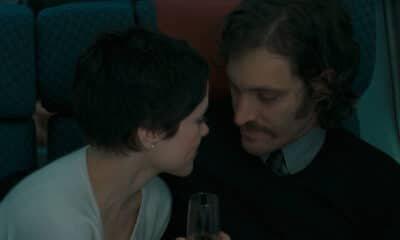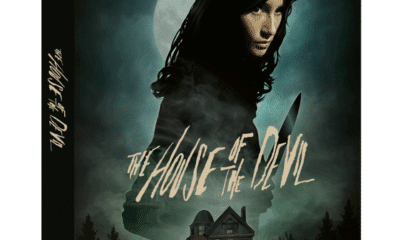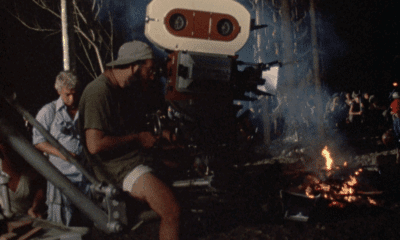
One of my favourite movies of kast year is the superb Me and Earl and The Dying Girl. It’s a truly delightful film that hits the home formats on 11th January. Thomas Mann, RJ Cyler and Olivia Cooke lead the cast of the film, but we caught up with film’s talented director Alfonso Gomez-Rejon who spoke about his movie.

What was it about Me And Earl And The Dying Girl that appealed to you as a filmmaker?
The idea that you can learn about people after they die, you just have to pay attention. The second I read that line I thought ‘What a beautiful idea’. I had just lost someone very close to me – namely my father – and I was having difficulty incorporating loss into my life and making something out of it instead of letting it destroy me. It felt like a movie I could personalise. I saw myself in Greg [Thomas Mann] and the way he was dealing with death in the second half of the movie and like Greg I felt I’d be able to make something out of my feelings – to make a film about what I was feeling the way he’s doing in the film.
Why do you feel the film will repay repeated viewings on Blu-ray, DVD and digital download?
It’s the script and the performances and at the bottom of the list would be the directing [laughs]. They say that sometimes the most personal films become the most universal and this is a personal film made by a lot of people working together. There was a lot of love that went into every single frame, not just me but every crew member and maybe that’s palpable and tangible in some way. That’s why there’s so much more to the film than can be digested in just one viewing.
The film parodies are brilliant. Will there be more of those on the Blu-ray and DVD?
There will be, yes. Not too many more – maybe just two more. We tried to show them all in their entirety in the movie and with some of them what you see is all there is. For instance, My Dinner With Andre The Giant is just that shot and that’s it. But a few of them are longer so there’ll be an extended montage of the films that show more of them and some new ones too.
What are the other extras?
There’s a conversation between me and Martin Scorsese and deleted scenes. There’s a lot of great stuff on there.

Do you think having so many platforms to buy and watch films makes them more accessible?
I love the idea of having a shared experience in a dark room, but nowadays there are bigger screens and home theatres and I discovered film on VHS. Scorsese discovered movies on a black and white TV. Home entertainment platforms offer more outlets for filmmakers and for films that might not get a big cinema release.
The author of the book Jesse Andrews wrote the script but how does the film differ?
Jesse did an amazing job and he was quite brave in the fact the screenplay is different to the book and the finished film is different to the screenplay. He was very nimble in that way. Structurally he was able to fearlessly throw out a lot of material, then once I became involved he really helped shape it into what it became. The third act is a real departure.
What about the parodies?
They always made parodies, in both the book and the screenplay, but what films they parody evolved quite a bit and Greg’s final film was the biggest departure. My favourite parody in the film? Probably 2.48pm Cowboy or Don’t Look Now.
What are your favourite coming-of-age movies?
When I saw The Breakfast Club at age 12 it was the first time I saw myself on the screen, in the Anthony Michael Hall character. He was very much me and I felt: ‘Someone is able to say what I’m feeling. I’m a Mexican kid from the border of Texas and Mexico, I’m not very articulate, I’m quite shy and all of a sudden he’s feeling everything I’m feeling and he’s saying everything I’m feeling’. Later on it was when I saw Mean Streets and I saw myself in that movie. That’s when I realised ‘Movies have this power to them because I’m not living in Little Italy in the 1970s but somehow it speaks to me’. To a certain extent The 400 Blows resonated with me like that and even After Hours because when you’re single and 40 and trying to date in a way that’s also a coming-of-age movie. There’s also The Outsiders and River’s Edge. There are a few movies where you see yourself or want to see yourself, where they tap into a world you want to be a part of or they capture the world as you’ve been living it.

What do you hope viewers will get from watching the film?
I hope that like me they’ll experience real emotion and they won’t feel cheated or manipulated. That’s my big thing. Because I was going through something too and I was trying to capture something I wanted to be very respectful of the audience as well and not make it easy to get an emotion by putting a certain cue on. I wanted to restrain that so if you feel then you feel and if you don’t I’m not going to force it. Take the journey, take a ride, and hopefully the idea that people’s stories continue to unfold and you just to pay attention is an idea that maybe some people will find comforting now or later.
What were your visual influences?
Chung-Hoon Chung [the director of photography] and I knew that the beginning of the movie was going to be very controlled, very-stylized and hyper-real – that this is a young filmmaker seducing you and telling you a story. Then it would become looser and simpler and out of his control. He was going to learn how to pay attention and learn how to be quiet and the film would do the same. We watched a lot of films together and we knew it would be stylized and controlled, then visually looser and quieter.
Is there anything of you in the character of Greg?
There is, yes. Certainly his emotional journey from beginning to end is something I was going through. It’s something I felt, at age 40, exactly the way he is feeling it and how he’s trying to make sense of it. That’s why I love Thomas so much and what he did with it. He was responsible towards Greg but also towards me going through that same journey as him. I was never as smart or as funny as Greg and I never made such interesting parodies as a kid, but the love for film was there as was the trying to fit in everywhere but nowhere, just coasting through high school wanting to be invisible. Who he is at the end, I’m there now.
Did your father ever serve up strange and interesting dishes the way Nick Offerman’s character does in the film?
I’m from Mexican parents, on the border of Texas but we weren’t allowed to speak English at home so we wouldn’t forget our language and our heritage. Also my mum’s family is Basque so yes, we had weird food. Mum was also this amazing chef and we’d learn about eating tempura with chopsticks and there was paella and lobster thermidor. She was that good a cook and she made every meal an event. Our house was a go-to place for a lot of our friends.

How did you select Brian Eno to compose the music for the soundtrack?
I carefully collaborated with my editor David Trachtenberg and with Randall Poster, the music supervisor. It started out with music from other movies and that’s what I originally wanted to do – to use music from The Conversation and The 400 Blows and film music by Bernard Hermann. Some of it was going to be so subtle that if you weren’t familiar with the score from, say, The Conversation you’d just assume it was the score from my film. Sometimes it was over the top, like a reference to Vertigo, but then Brian Eno scored the film that Greg makes for Rachel [Olivia Cooke] and it was the last scene we shot. It had a power to it that was beyond anything I could have imagined and that began the journey of using Eno’s music, which happened in post-production until it became like another character in the movie. It was her narrative. Every time we went into her bedroom she was listening to him. Then Nico Muhly was hired to do the opening score, which also comes back for the end credits, and we approached Eno himself. He liked the movie and liked how his music was used in it and he started to write music for the film. It constantly evolved in ways I’d never planned.
Can you tell us a little about shooting on the Pittsburgh locations?
When I went on my first location scout around Pittsburgh it was almost like we were scouting it to eliminate it as a location and just shoot it closer to New York City where it would be cheaper and we’d have more experienced crews – although there are a lot of incredible crews in Pittsburgh. But in going to Pittsburgh I fell in love with the city; the verticality of it, the locations, the compositions. It felt fresh and the movie came alive. I went over to Jesse Andrews’ house to meet his parents and I fell in love with the house and suddenly I was looking for houses that were similar. I saw eight high schools and didn’t like any of them because they looked like high schools that had been in other movies, then we were able to get into Schenley High School which had been shuttered for six years and that became its own character in the film.
You can watch a deleted scene from the film below.
Me and Earl and The Dying Girl is out on Digital HD and on DVD 11th January.

Latest Posts
-


Film News
/ 2 days agoNew promo for ‘Popeye the Slayer Man’ arrives ahead of Prime SVOD release
Following in the footsteps of Winnie-the-Pooh, Popeye is one of the latest properties to...
By Kat Hughes -


Television
/ 4 days agoHarry Potter, Hermione Granger and Ron Weasley cast in new HBO Max series
The three main child roles in the planned Harry Potter TV series have been...
By Paul Heath -


Netflix
/ 4 days agoNetflix unveils a ‘One Piece’ announcement video
One Piece season two is officially a go and here’s a two-minute teaser for...
By Paul Heath -


Film News
/ 4 days ago‘Sinners’ will come to premium digital in one week
One of the best-reviewed studio films of the year, and indeed one of the...
By Paul Heath





